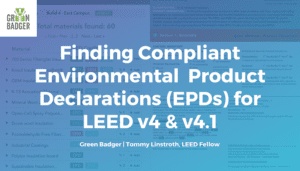
Construction teams have to make dozens of decisions every single day to make sure that projects are delivered on time and under budget. The pressure to make the best decision possible can be daunting when faced with several options that seem to all provide value. The challenge is picking the best option based on the values that are most important to the team and the construction owner.
One of the choices many teams have to make is how they will handle the LEED documentation. Do it in-house? Hire a consultant to help? Use Green Badger? Although we think that Green Badger is definitely the way to go, each option does have pros and have different costs. How does a team determine the best value?
Luckily, there are ways to make the decision making process easier. Choosing By Advantages (CBA) is a Lean tool that can help evaluate options based on the advantages each option provides. We have decided to do a LEED documentation CBA to prove that Green Badger adds the most value for the lowest cost!
Step 1: Identify options
- Use Green Badger
- Hire a LEED consultant
- Keep it in-house with a Project Engineer
Step 2: Identify the factors that differentiate each option. NOTE: this can’t include cost. Cost comes in at the very end. When it comes to LEED documentation, many GCs are often evaluating:
- The time spent on LEED documentation each month
- The amount of stress endured by the GC team
- The transparency of the LEED documentation process between team members
Step 3: Determine the preferred criteria for each factor
- The time spent on LEED each month
- Less time is better
- The amount of stree endured by the GC team
- Less stress is better
- The transparency of the LEED documentation process between team members
- High transparency is better
Step 4: Summarize the characteristics of each option.

Step 5: Determine the least preferred criteria for each option. In this example, it would be the most hours, highest stress level, and lowest amount of transparency.

Step 6: Next, we are going to determine the advantages of the remaining options, compared to the least preferred options you identified in step 5.
Our advantages are 18 fewer hours spent on LEED per month, 10 fewer hours spent on LEED per month, much less stress, and much more transparency.

Step 7: Quantify the importance of each advantage you identified in Step 6. To do this, create a number line from 0 to 100 and plot the importance of each.
- 100 – 18 fewer hours spent on LEED per month
- 85 – much less stress
- 75 – 10 fewer hours spent on LEED per month
- 60 – much more transparency between team members

Next, add up the total Importance of Advantages for each option.

Step 8: Last, we are going to compare the importance of the advantages to the cost for each option. Cost is always saved for last. It’s very important to consider however, you don’t want it to be the only thing you consider.
The estimated costs come from the assumption that the hourly rate for a PE is $70/hr, a consultant has a flat rate of $2000/month, and the Green Badger Essentials Project License is $250/month.

This graph will show the highest value compared to cost, since it has the steepest line. As you can see, not only is Green Badger providing value to your team, it’s saving you money!





